Morgan Library & Museum
The Morgan Library & Museum—formerly the Pierpont Morgan Library—is a museum and research library located at 225 Madison Avenue at East 36th Street in the Murray Hill neighborhood of Manhattan, New York City. It was founded to house the private library of J. P. Morgan in 1906, which included manuscripts and printed books, some of them in rare bindings, as well as his collection of prints and drawings. The library was designed by Charles McKim of the firm of McKim, Mead and White and cost $1.2 million. It was made a public institution in 1924 by J. P. Morgan's son John Pierpont Morgan, Jr., in accordance with his father's will.
J. Pierpont Morgan Library | |
 (2006) | |
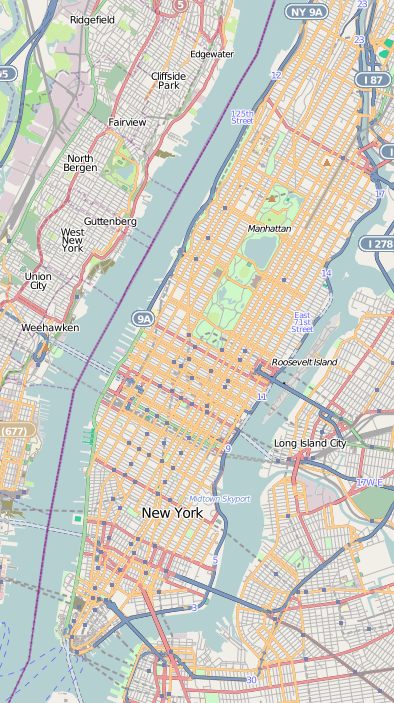 Morgan Library & Museum  Morgan Library & Museum  Morgan Library & Museum | |
| Location | 225 Madison Avenue at East 36th Street Manhattan, New York City |
|---|---|
| Coordinates | |
| Built | 1900–06[1] |
| Architect | Charles Follen McKim[2] |
| Architectural style | Palladian |
| Website | TheMorgan.org |
| NRHP reference No. | 66000544[1] |
| Significant dates | |
| Added to NRHP | November 13, 1966[1] |
| Designated NHL | November 13, 1966[3] |
| Designated NYCL | May 17, 1966 |
The building was designated a New York City landmark in 1966[4] and was declared a National Historic Landmark later that same year.[3][5][6]
Collection
Today the library is a complex of buildings which serve as a museum and scholarly research center. The scope of the collection was shaped in its early years as a private collection by Belle da Costa Greene, J.P. Morgan's personal librarian, who became the library's first director and served from the time that it became public until her retirement in 1948. Her successor Frederick Baldwin Adams, Jr. managed the Library until 1969 and was also world-renowned for his own personal collections. The most internationally significant part of the collection is its relatively small but very select collection of illuminated manuscripts, and medieval artworks such as the Stavelot Triptych and the metalwork covers of the Lindau Gospels. Among the more famous manuscripts are the Morgan Bible, Morgan Beatus, Hours of Catherine of Cleves, Farnese Hours, Morgan Black Hours, and Codex Glazier. The manuscript collection also includes authors' original manuscripts, including some by Sir Walter Scott and Honoré de Balzac, as well as the scraps of paper on which Bob Dylan jotted down "Blowin' in the Wind" and "It Ain't Me Babe".
It also contains a large collection of incunabula, prints, and drawings of European artists—Leonardo, Michelangelo, Raphael, Rembrandt, Rubens, Gainsborough, Dürer, and Picasso; early printed Bibles, among them three Gutenberg Bibles; and many examples of fine bookbinding. Other holdings include material from ancient Egypt and medieval liturgical objects (including Coptic literature examples),[7] Émile Zola, William Blake's original drawings for his edition of the Book of Job; concept drawings for The Little Prince by Antoine de Saint-Exupéry; a Percy Bysshe Shelley notebook; originals of poems by Robert Burns; a unique Charles Dickens manuscript of A Christmas Carol with handwritten edits and markup from the author; a journal by Henry David Thoreau; an extraordinary collection of autographed and annotated libretti and scores from Beethoven, Brahms, Chopin, Mahler and Verdi, and Mozart's Haffner Symphony in D Major; and manuscripts of George Sand, William Makepeace Thackeray, Lord Byron, Charlotte Brontë and nine of Sir Walter Scott's novels, including Ivanhoe. The collection still includes a few Old Master paintings collected by Morgan between 1907 and 1911 (works by Hans Memling, Perugino, and Cima da Conegliano), but this has never been the collection's focus, and Ghirlandaio's masterpiece Portrait of Giovanna Tornabuoni was sold to Thyssen when the Great Depression worsened the Morgan family's finances.[8]
Other notable artists of the Morgan Library and Museum are Jean de Brunhoff, Paul Cézanne, Vincent van Gogh, John Leech, Gaston Phoebus, Rembrandt van Rijn, and John Ruskin.[9] In 2018, the Morgan acquired the drawing Bathers by Renoir, a previously unexhibited work.[10]
The Morgan has one of the world's greatest collections of ancient Near Eastern cylinder seals, small stone cylinders finely engraved with images for transfer to clay by rolling.[11] It also contains many music manuscripts and a considerable collection of Victoriana, including one of the most important collections of Gilbert and Sullivan manuscripts and related artifacts.[12]
Of interest to Australians is a copy of the letter written by Andrea Corsali from India in 1516. This letter, one of five in existence, contains the first description of the Southern Cross which is also illustrated by Corsali in this letter and which was also named "croce" by him. One other copy of the letter is in the British Library and two are in Australia. The fifth is in the Library of Princeton University. The letter is also readily available in Ramusio's Viaggi, a compendium of letters of exploration, published in Venice in three volumes from 1555.
Architecture
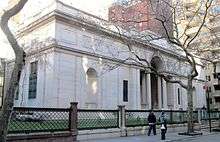
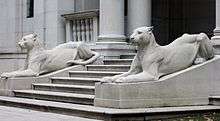
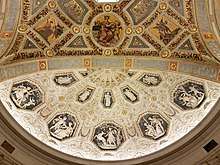
The first building constructed to house Morgan's library – the "McKim Building" – was designed in the Classical Revival style by Charles Follen McKim of the noted firm of McKim, Mead & White in 1903. Morgan also commissioned a house to be built for his daughter a block away at the same time. It is located at 33 East 36th Street, which was at the time just to the east of Morgan's residence, a brownstone house at 219 Madison Avenue built in 1880. McKim took his inspiration from the Villa Giulia and its Nymphaeum.[4] The building was constructed from 1902-1907 and has a facade of Tennessee marble and a Palladian arch entrance which features two lionesses sculpted by Edward Clark Potter, who would later create the two lions that guard the New York Public Library Main Branch.[4][13] Also in the entrance are roundels and panels by Andrew O'Connor and Adolph Weinman.[4]
The interior of the building is richly decorated, with a polychrome rotunda which leads to three public rooms, which were originally Morgan's private study, the librarian's office, and the library itself.[13] The rotunda itself has a domed ceiling with murals and plasterwork inspired by Raphael, created by H. Siddons Mowbray. Morgan's study, now the West Library, has been called "one of the greatest achievements of American interior decoration," while the East Library features triple-tiers of bookcases.[4]
Morgan's residence was torn down in 1928, after his death, to be replaced by an annex building which featured an exhibition hall and a reading room, designed by Benjamin Wistar Morris to harmonize with McKim's original.[4]
.jpg)
The remaining Italianate brownstone house in the library complex is 231 Madison Avenue, on the corner of East 37th Street. This house was built by Isaac Newton Phelps who bequeathed it to his daughter, Helen Stokes, wife of Anson Phelps Stokes. She extended the building, doubling the size and adding an additional attic floor (architect R. H. Robertson). Their son, architect Isaac Newton Phelps Stokes, was born in the house on April 11, 1867. The house was purchased by J. P. Morgan in 1904. It was the home of his heir J. P. Morgan Jr. from 1905 to 1943.[2][14]
2006 renovation
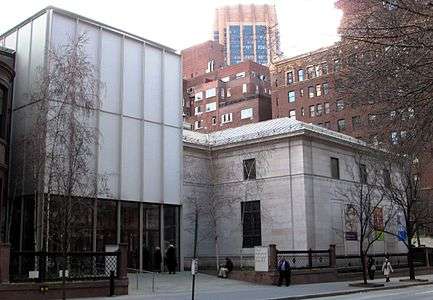
The most recent addition to the library is a modernist entrance building designed by Italian architect Renzo Piano – his New York City debut – and Beyer Blinder Belle, which was completed in 2006.[4] Although externally "bland", the building helps to organize the interior spaces of the complex.[2]
The Library was closed during the construction and expansion. In the interim, it sponsored numerous traveling exhibitions around the country. When the work was completed, it reopened on April 29, 2006 as the Morgan Library & Museum. With the expansion above and below street level, the Morgan's exhibition space had been doubled; Piano set its new reading room under a translucent roof structure, to allow scholars to examine manuscripts in natural light. Piano's four-story steel-and-glass atrium links McKim's library building and the Morgan house in a new ensemble. Added storage facilities were obtained by drilling into Manhattan's bedrock schist.
Management
Between 1987 and 2008, Charles E. Pierce Jr. served as director of what was then known as the Pierpont Morgan Library. During his tenure at the Morgan Library and Museum between 2008 and 2015, director William M. Griswold spearheaded the growth of its collections, exhibition programs and curatorial departments, adding a photography curator in 2013, a first for the institution. In an effort to reach a younger audience, he also presented many contemporary-art exhibitions and installed temporary sculpture in its atrium.[15] In 2015, the Morgan named Colin Bailey as its new director.[16]
In popular culture
The library was depicted in E. L. Doctorow's 1975 novel, Ragtime (as well as in Miloš Forman's 1981 American film version of the novel). In the story, set at the turn of the 20th century, character Coalhouse Walker and his gang of vigilantes storm the library, taking the priceless collection hostage and wiring the building with dynamite, provoking a standoff with police.
References
Notes
- "National Register Information System". National Register of Historic Places. National Park Service. July 9, 2010.
- White, Norval; Willensky, Elliot & Leadon, Fran (2010). AIA Guide to New York City (5th ed.). New York: Oxford University Press. p. 281. ISBN 978-0-19538-386-7.
- "J. Pierpont Morgan Library". National Historic Landmark summary listing. National Park Service. September 18, 2007. Archived from the original on October 10, 2012.
- New York City Landmarks Preservation Commission; Dolkart, Andrew S.; Postal, Matthew A. (2009). Postal, Matthew A. (ed.). Guide to New York City Landmarks (4th ed.). New York: John Wiley & Sons. p. 98. ISBN 978-0-470-28963-1.
- Greenwood, Richard (July 18, 1975). ""The Pierpont Morgan Library", National Register of Historic Places Inventory-Nomination". National Park Service.
- "National Register of Historic Places Inventory-Nomination". National Park Service. July 18, 1975.
- "CATHOLIC ENCYCLOPEDIA: Coptic Literature". Newadvent.org. March 1, 1914. Retrieved June 18, 2012.
- Kandell, Jonathan. "Baron Thyssen-Bornemisza, Industrialist Who Built Fabled Art Collection, Dies at 81," New York Times, April 28, 2002.
- "The Morgan Library & Museum: About". ARTINFO. 2008. Retrieved July 30, 2008. Cite journal requires
|journal=(help) - "Acquisitions of the month: November 2018". Apollo Magazine.
- "Overview of Morgan seal collection". Themorgan.org. Retrieved June 18, 2012.
- Wilson, Frederic Woodbridge. The Gilbert and Sullivan Collection Archived January 5, 2009, at the Wayback Machine at The Morgan Library website, accessed May 5, 2010
- Nevius, Michelle & Nevius, James (2009), Inside the Apple: A Streetwise History of New York City, New York: Free Press, ISBN 141658997X, pp.197-198
- Stokes, Anson Phelps (1915). Stokes Records (Vol. 3 ed.). Privately. p. 13.
- Vogel, Carol (May 20, 2014). "Cleveland Hires Leader of Morgan". The New York Times. ISSN 0362-4331. Retrieved June 15, 2019.
- Pac Pobric (April 17, 2015), Colin Bailey named head of the Morgan Library and Museum Archived April 18, 2015, at the Wayback Machine The Art Newspaper.
Further reading
- Morgan, John Pierpont (1919). List Of Coptic Manuscripts In The Pierpont Morgan Library. New York: privately printed.
- Voelkle, William "Morgan Mansion" (letter to the editor) The New York Times, (July 18, 1982)
External links

- Official website
- St. Benard's Obit for Frederick Baldwin Adams Jr.

